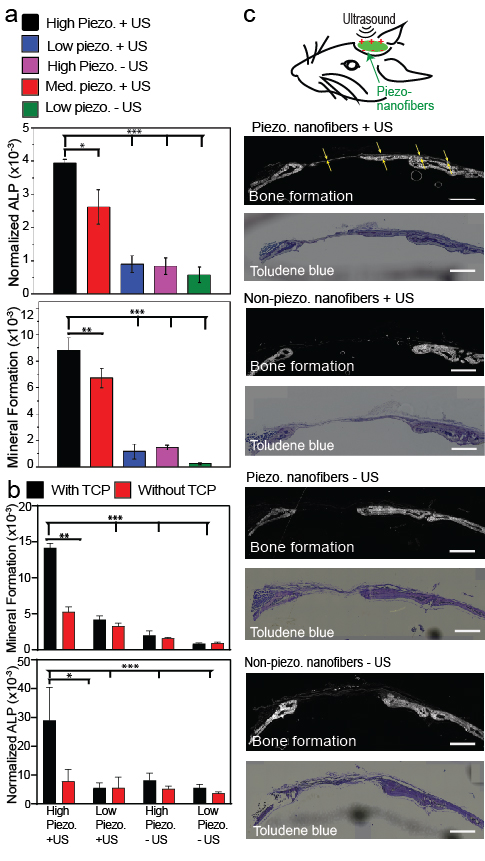Introduction: Treatment of large fractures and bone void defects is one of the biggest challenge in orthopedic. Current state of the art reconstructions include autografts and allografts both of which have serious disadvantages like lack of supply and rejection. Regenerative engineering strategies propose the use of biomaterial scaffolds, autologous stem/osteogenic cells and growth factors/small molecules to create artificial bone grafts. Although regenerative engineering strategies have a huge potential for success, it requires the use of large amounts of small molecules and growth factors which can have toxic and harmful side effects in high doses. Electrical stimulation (ES) is an alternative technique that can induce bone repair and regeneration without the use of high amounts of growth factors. However, current electrical stimulation devices are either external stimulators (whose signal gets weakened by absorption by skin and muscles before it reaches the bone) or implanted devices (that rely on toxic non-biodegradable batteries). Piezoelectric materials that are a group of âsmartâ materials which can generate electricity under applied force, might offer interesting battery-less stimulators to stimulate bone growth. Bone tissue also happens to be piezoelectric in nature. Under deformation from body weight, it generates surface charge, which is the driving force in bone remodeling. A piezoelectric scaffold, therefore, can potentially mimic natural bone in receiving mechanical loading to induce bone repair. Hence, we present a biodegradable and biocompatible scaffold of piezoelectric polymer of PLLA (Poly-L-lactide), which can be incorporated with Tri-calcium phosphate (TCP) and subjected to acoustic pressure from ultrasound, to generate useful electrical charge for enhanced bone regeneration
Materials and Methods: We have employed a powerful piezoelectric PLLA film1, 2 that is fabricated using an electrospinning box with higher collector drum speeds. We use a co-electrospinning technique to incorporate Tri-calcium phosphate (TCP) into our nanofiber films. We seed adipose derived stem cells on the film and subject it to ultrasound (US). This generates useful surface charge, which significantly enhances bone regeneration. Using cell-based assays, we assess osteogenesis of the stem cells seeded on the scaffolds under applied ultrasound in vitro. In vivo experiments were also performed by implanting scaffolds inside calvarial defect of mice and applying non-invasive ultrasound (US) to observe bone regeneration.
Results and Discussion: Through ALP assay and Alizarin red assay we found a significant increase of osteogenic differentiation of the stem cells, cultured on piezoelectric scaffold under applied US, both with and without TCP (Figs. 1a-1b). We also saw significant increase in the expression of genes like osteocalcin and osteorix in these groups (data not shown). In vivo experiment also shows an enhanced bone formation on the implanted piezoelectric scaffold, subjected to the external US as compared to groups receiving non piezoelectric scaffolds (Figs. 1c) or no US (data not shown).
Conclusions: Our piezoelectric material is biodegradable, which is a critical property for tissue scaffold and has not been achieved by any other reported piezoelectric materials. The presented piezoelectric PLLA material therefore offers a significant and unique biodegradable scaffold, which is inherently a biodegradable and wirelessly-controlled electrical stimulator enhancing regeneration by incorporation of tri-calcium phosphate.
References: 1. Curry, E. J. et al., PNAS 2018, 115, (5), 909-914. 2. Curry, E. J. et al., PNAS 2020, 117, (1), 214. 3. Das, R. et al., Nano Energy, 2020, 105208.
Image Caption:
Figure 1. a. ALP assay and Alizarin red assay results for scaffolds (without TCP) with different levels of piezoelectric properties. b. ALP assay and Alizarin red assay results comparing scaffolds with or without TCP. c. Representative Images /histological slides of the mouse skull bone after 6 weeks of receiving the piezoelectric or non-piezoelectric PLLA with applied US. The staining and images show clearly a significant bone formation from the mice receiving the biodegradable piezoelectric nanofibers with applied US, compared to the control. * = 0.01, ** = 0.001, *** =0.0001. Student paired t-test.


